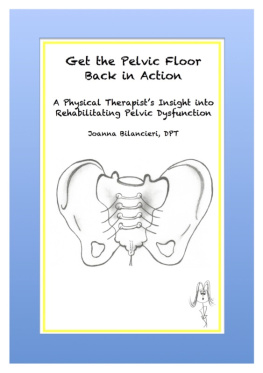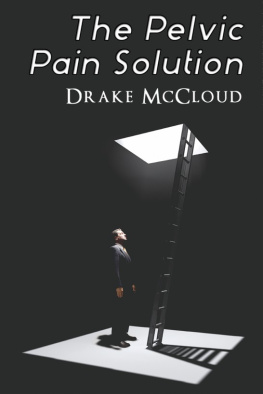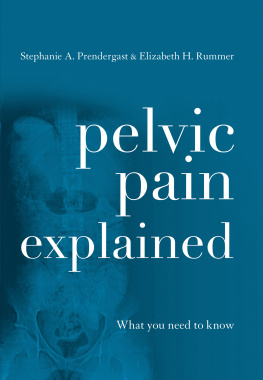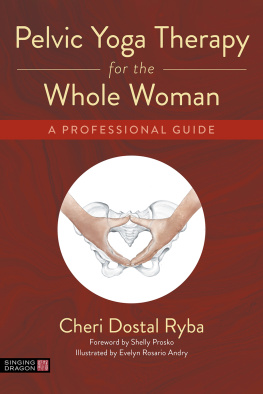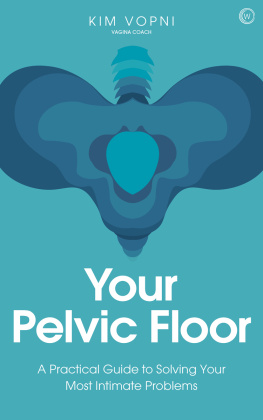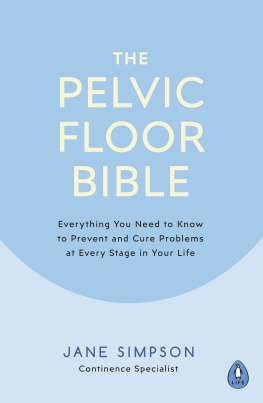Copyright 2015
ISBN: 978-1-6822291-2-5
Thank YouYes, You, My Patients!
To each and every patient who walked into my office, thank you. Thank you for the enlightening opportunity to work with you, to treat you, and to help you help yourself with your conditions. Without each and every one of you, this book would not be complete. Pelvic conditions are the lemons, but together we made, and continue to make, some amazing lemonade!
Table of Contents
Disclaimer
The author, illustrator, editor, printer, formatter, and publisher of this book recommend seeking medical attention for medical advice. The contents of this book do not substitute for the medical attention and the needs addressed by individuals clinicians. The author, illustrator, editor, formatter, printer, and publisher of this book intend to present correct information at the time of press. Any and all information utilized is at the readers own risk. If any techniques, exercises, treatments, instructions, and/or other materials are utilized, the reader does so at his or her own will and risk. Any performance or use of the techniques, exercises, treatments, instructions, and/or other materials is at the readers own will and risk and should not be performed or utilized if any harm or pain develops or worsens. The author, illustrator, editor, printer, formatter, and publisher of this book do not assume and do disclaim liability for any errors or damages resulting from any cause.
Prologue
Hello!
I was wondering if you treat patients with pelvic pain. I have endometriosis
Amidst writing this book, I received a phone call from a woman with a timid, yet hopeful voice. This sweet voice so very politely asked if I treated patients with pelvic pain, particularly those with endometriosis. I responded with a calm, drawn out, yet emphatic, Yyyesss. My tone and answer induced a smiling sigh of relief and a welling tear on the other end of the line. The womans voice resonated with hope, as if a long arduous journey had ended, and she was ready to venture through the proverbial tunnel with a beaming light calling her name. We talked about the ways we could together tackle her condition and we set an appointment to meet. Upon hanging up the telephone, I smiled. Tears of fulfilling joy rolled down my cheek. Those very words fueled my fire to continue to decipher the complexities of pelvic disorders and to help lead patients down the road to recovery.
A Bit About Me, the Author
I would like to take you on a journey healing several debilitating conditions that involve the pelvic region. My strategies incorporate research as well as cases I have seen from 2001 to the present. Men have pelvic floor disorders, such as urinary incontinence and pelvic pain, and do indeed greatly benefit from pelvic floor rehabilitation. However, the number of women I have treated is by far greater than the number of men. Therefore, the cases I present on this journey are women who have overcome or managed a myriad of conditions of pelvic dysfunction.
As a college undergraduate I was fortunate to attend Yale University, focusing my attention on pre-medical biology with an emphasis in physiological psychology. I also delved into anthropology and history. My coursework intertwined bodily systems with cultural and artful underlays and ignited my appreciation for all of lifes functions. I left Yale understanding that even the most minute details are integral segments of the art form we call a human being.
While studying for my Doctorate of Physical Therapy at the University of Southern California, one of my research projects targeted the evaluation and treatment of urinary incontinence, even though incontinence was not embedded in USCs curricula. After my groups presentation, however, my professors informed me that they would see to it that incontinence was indeed added to the curricula in the ensuing years.
Having just graduated and excited to start my career as a physical, or physio-, therapist, a serendipitous opportunity arose to work side by side with a brilliant, world-renowned urogynecologist and obstetrician by the name of Dr. Cynthia Mosbrucker. I was fortunate to witness her surgeries and to treat mutual patients. In 2007, I established my own boutique-style practice, small and individualized, and continued to benefit from the interactions with my urogynecologist/obstetrician friend. To this day, we continue to work as a team, as I do with many clinicians in rehabilitating pelvic dysfunction. Together, we strive to succeed at conquering pelvic conditions.
Over the years, I have encountered remarkable cases of pelvic dysfunction that required thinking inside, outside, and all around the proverbial box. Cases such as stress urinary incontinence, urinary urgency and frequency, incomplete voiding, pelvic pain, scoliosis, back pain, neuritis, sacroiliac dysfunction, endometriosis, interstitial cystitis, painful intercourse, and persons with any combination of these conditions have walked into my care. My intent as the author of this book is to share my clinical findings and gathered opinions. When the question why is left unanswered by my literature searches, I share my own speculations. As of the completion of this piece, I had not found literature to support all of my findings. Furthermore, my intent is not to inundate my audience with a plethora of research articles. My findings left unsupported by literature are open for discussion. I hope to spawn interest in my readers to continue the search for the many possible answers to the question why, to perform individual research, and to report back! Medical science is a team effort, and with a team, more questions can be answered and more cases can be treated successfully.
I welcome audiences of all backgrounds: Patients, clinicians, folks concerned about partners, friends and family members of those with pelvic dysfunction, and folks looking to minimize the chance of becoming a patient.
What Is My Specialty?
People. I Specialize in People.
Although pelvic rehabilitation is considered a specialty, I do not find it appealing to be considered a specialist in any one type of therapy. In my opinion, in order to adequately treat, a view of the whole person is paramount. Only when we see how all the bodily systems interconnect can we fully rehabilitate. Thus, to the ever-present question, What is my specialty? I respond, People. I specialize in people.
Acquiring a solid background in physical, or physio-, therapy lays the groundwork for rehabilitating pelvic dysfunction. Such knowledge includes the mindfulness that the whole body is connected in one way or another. Orthopedic, neurological, and psychological conditions may all seep into the pelvic region and contribute to pelvic disorders. Considering all systems is imperative to unlocking the rehabilitative code.
Numerous conditions revolve around inadequate control of the pelvic floor musculature. Some conditions are straightforward and uncomplicated. Oftentimes, however, multiple conditions weave together into a loom that requires intricate thought and dissection. Singly, one impairment may not have too detrimental of an effect on a patients function. However, adding one impairment to another may create a scenario such as that of the proverbial straw. In cases of pelvic dysfunction, each straw must be discovered and conquered to get patients on the mend and back in action!

